Free Online Productivity Tools
i2Speak
i2Symbol
i2OCR
iTex2Img
iWeb2Print
iWeb2Shot
i2Type
iPdf2Split
iPdf2Merge
i2Bopomofo
i2Arabic
i2Style
i2Image
i2PDF
iLatex2Rtf
Sci2ools
ICCS
2007
Springer
2007
Springer
Validating Evolving Simulations in COERCE
We seek to increase user confidence in simulations as they are adapted to meet new requirements. Our approach includes formal representation of uncertainty, lightweight validation, and novel techniques for exploring emergent behavior. Uncertainty representation, using formalisms such as Dempster-Shafer theory, can capture designer insight about uncertainty, enabling formal analysis and improving communication with decision and policy makers. Lightweight validation employs targeted program analysis and automated regression testing to maintain user confidence as adaptations occur. Emergent behavior validation exploits the semi-automatic adaptation capability of COERCE to make exploration of such behavior efficient and productive. We describe our research on these three technologies and their impact on validating dynamically evolving simulations.
| Added | 08 Jun 2010 |
| Updated | 08 Jun 2010 |
| Type | Conference |
| Year | 2007 |
| Where | ICCS |
| Authors | Paul F. Reynolds Jr., Michael Spiegel, Xinyu Liu, Ross Gore |
Comments (0)

